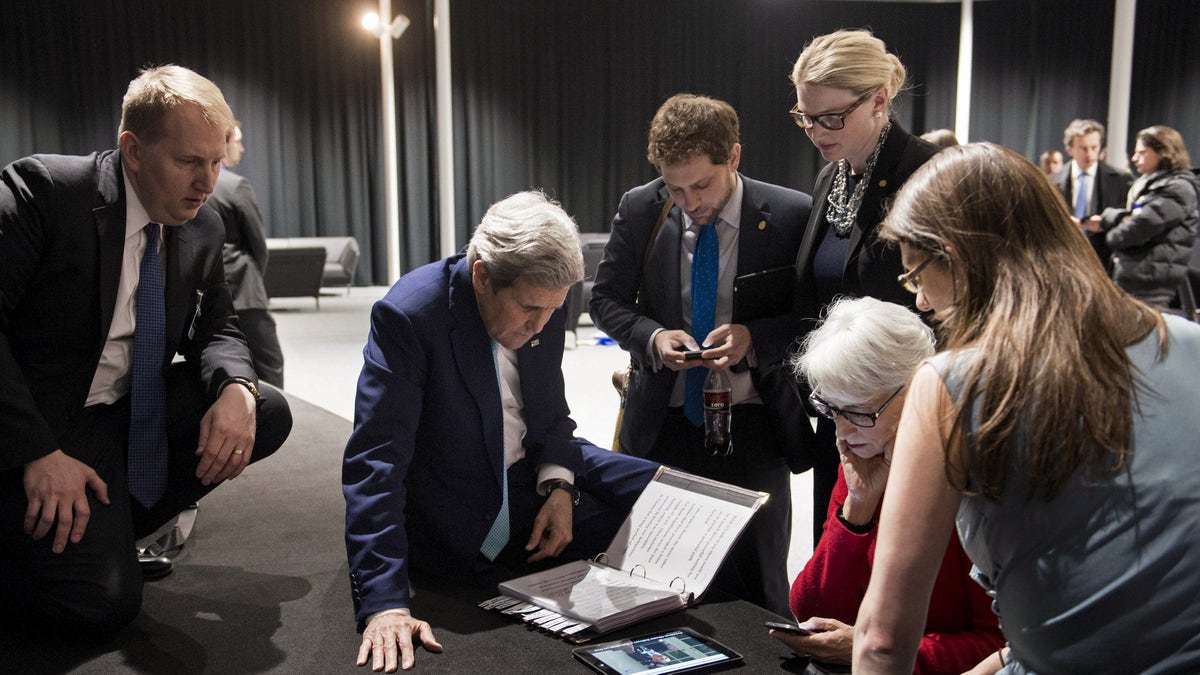
Cyber experts fear the deal being negotiated with Iran to ease sanctions in return for a pledge to drop pursuit of nuclear weapons could boost Iran's ability to wage cyber war. (REUTERS)
They sat down at a table and negotiated.
Two nations with thousands of nuclear-tipped, inter-continental ballistic missiles (ICBM’s) strategically pointed at one another faced the potential for untold disaster. Those weapons were poised to kill tens of millions of people and pitch the world into an unprecedented apocalypse.
In the late 1960s, the Union of Soviet Socialist Republics found itself in a race to attain arms parity with the better-armed United States.
President Lyndon Johnson’s defense secretary, Robert McNamara, thought it was “an insane road to follow” as both nations attempted to keep pace with the other. That’s why Johnson and his successor, President Richard Nixon, embarked on a series of negotiations with their Soviet counterparts.
The negotiation and others that followed with Russia -- and the role Congress has played in them -- serve as prologue to the tentative nuclear deal the United States has with Iran and a scheduled vote next week in the Senate to give congressional overview to the agreement.
The U.S.-U.S.S.R. negotiations began with the Anti-Ballistic Missile (ABM) treaty, agreed to by Nixon and Soviet leader Leonid Brezhnev in 1972. What soon followed were Strategic Arms Limitations Talks (SALT I & SALT II).
President Jimmy Carter and Brezhnev signed SALT II in June 1979. The accord restricted the delivery vehicles each nation could have for nuclear weapons. Relations between the superpowers were improving after bottoming out with the Cuban Missile Crisis of the 1960s.
But something else gurgled that threatened to derail the relations.
The Soviets were on the move and soon invaded Afghanistan. Nineteen U.S. senators penned a letter to Carter arguing that SALT II wouldn’t form military balance between the nations. In early 1980, Carter formally requested that the Senate not provide constitutional advice and consent on the treaty, let alone ratify it. Despite never forging the pact, the two countries voluntarily adhered to the framework of SALT II until late 1985.
During this time, American and Soviet diplomats worked on yet another deal: the Strategic Arms Reduction Talks (START).
Note the trend in the names of these sessions. They morphed from limiting the number of weapons each side could have in SALT to reducing the total arsenals of both nations in START.
The U.S. wouldn’t have to give up quite as much under START, considering the way the Pentagon arranged the American nuclear stockpile. Meanwhile, the Soviets had a lot more to lose due to the cumulative power of nuclear weaponry that eventually outmatched the U.S three-to-one.
Then came the infamous summit between President Ronald Reagan and Soviet General Secretary Mikhail Gorbachev in Reykjavik, Iceland, in fall 1986.
Gorbachev arrived at the table with a stunning plan to eliminate all nuclear ballistic missiles. It was a proposal that could have fundamentally altered the course of history. Yet Reagan wouldn’t budge from his commitment to craft the Strategic Defense Initiative.
SDI was a space-centered weapons system. Liberals decried SDI as fantasy from Star Wars. As a result, “Star Wars” emerged as the program’s name in popular culture. But call it Star Wars or SDI, the entire thing freaked out the Kremlin.
The Reykjavik Summit adjourned abruptly over the SDI issue. Reagan questioned Gorbachev if he would “turn down an historic opportunity because of a single word” in the proposed treaty over SDI. The stalemate stunned Gorbachev.
“Can’t we do something about this?” the Soviet general secretary asked of the American president as they donned their coats.
“It’s too late,” Reagan snapped.
“I don’t know what else I could have done,” said Gorbachev to Reagan.
“I do,” replied the Gipper. “You could have said ‘yes.’ ”
But the implosion of the Reykjavik summit forced a fundamental reset between Washington and Moscow. Gorbachev knew the Soviets couldn’t compete with SDI, even if it was myth. The Soviet economy was already in shambles because of profligate military spending.
Gorbachev had to counter with something that would appeal to the Americans. The failure of Reykjavik paved the way for what became the Intermediate-Range Nuclear Forces Treaty (INF) a few years later. The INF pact became the first treaty requiring the sides to actually start slashing weapons, rather than merely harnessing proliferation.
But the end was near. The U.S.S.R.’s misadventure in Afghanistan ended with the withdrawal of troops in the late 1980s. The Soviet Union dissolved by the end of 1991. The curtain fell on the Cold War. And despite coming very close to nuclear blows during the Cuban Missile Crisis, the U.S. and Soviet Union managed to escape the decades-long exercise without exchanging nuclear volleys.
Today, Republicans and some Democrats are irate about the tentative blueprint negotiated by Secretary of State John Kerry and other nations with Iran on its nuclear program. Some were upset that the U.S. was even talking with Iran. Others are skeptical about Iran’s intentions. Many worry that the possibility of an Iranian nuke could devolve the Middle East into utter chaos, posing threats to the U.S. and Israel.
Yet, it’s worth asking if negotiating with Iran is any more treacherous than talking with and trusting the Soviets during the Cold War?
Granted, the U.S. and U.S.S.R. reached a state of détente because a misstep guaranteed utter destruction for both sides. In fact, that circumstance seems to have created a paradox. With mutually-assured destruction, the Cold War may have ironically made the globe safer than the scenario the world now faces with the potential for asymmetric warfare and a nuclear-armed Iran.
But that doesn’t mean American presidents didn’t encounter apprehension if not downright defiance over cutting deals with the Communists.
In 1979, after penning the SALT II deal with Brezhnev, Carter winged his way back to Washington to face what was described by the Toronto Globe and Mail as an “angry Senate.” At the end of the signing ceremony in Vienna, Carter went to shake hands with Brezhnev. Instead, the Soviet leader rose, grabbed Carter and planted a kiss on both of his cheeks.
Imagine the howling from Republicans if something like that went down between President Obama and Iranian Ayatollah Ali Khamenei.
“I think the president should have rebuked him,” protested then-Sen. Jake Garn, R-Utah, after Brezhnev extolled the agreement.
Then-Senate Minority Leader Howard Baker, R-Tenn., jumped into the presidential sweepstakes in November, 1979. He did so using SALT II as a fulcrum for political leverage.
“America has lost its margin for error,” Baker claimed. “Approval of this treaty with its acceptance of Soviet strategic superiority could guarantee to the Soviet Union the margin for error that used to be ours.”
There is a modern-day twist with Iran that may have doomed SALT II from the beginning. The Iranian revolution started in fall 1979. Extremists seized American hostages at the U.S. embassy in Tehran and militants overthrew the Shah.
“The Iranian situation is hardening the stance of many people as far as SALT (II) is concerned,” said then-Senate Minority Whip Ted Stevens.
The Alaska Republican said senators may dispatch the treaty back to committee, unwilling to grapple with such a major accord amid other flashpoints of international chaos.
The late-Sen. Malcom Wallop, R-Wyoming, a long-time arms control expert, derided START as “a ruse, a dream and a prayer to the tooth fairy.”
Then-Sen. Fritz Hollings, D-S.C., blasted the INF pact as an “act of retreat and said the deal presented “a clear and present danger to NATO’s security.”
Of course, the Senate always wants to weigh-in on international agreements when the U.S. is a signatory. That’s why there’s a big push next week for the Senate to advance the measure backed by Senate Foreign Relations Committee Chairman Bob Corker, R-Tenn., on the Iran plan. Corker’s bill would demand Congressional overview of the Iran deal and require lawmakers to approve a cessation of sanctions.
That was no different when the Senate wrestled with the INF measure.
“The Senate has clearly made visible that it is an equal partner with any president in the making of treaties,” said then-Senate Majority Leader Robert Byrd, D-W.V. “And I hope that will be a sobering impact on this president and Mr. Gorbachev when they sit down and discuss another agreement.”
At one point, Byrd even delayed consideration of the INF treaty when problems arose as to whether the Soviet Union would comply with the new weapons inspections regime.
“You have to be very careful, very sure when you ratify a treaty,” said then-Senate Armed Services Committee Chairman Sam Nunn, D-Ga.
Finally, the treaty was ready for passage.
“I’m licked in terms of doing anything on the treaty,” lamented one of the most-vociferous opponents of the INF gambit, the late-Sen. Jesse Helms, R-N.C.
Of course, most of what we’ve discussed here focuses on Article II, Section 2 of the Constitution. It gives the Senate the power to ratify treaties, “provided two-thirds of the senators present concur.”
The provisional construct of the Iran deal is not even a formal treaty. In fact, this deal might not even take the form of an actual signed piece of paper. And the way the Obama administration is tentatively preparing the language, it doesn’t take the form of a typical treaty, which would be sent to the Senate for ratification under the Constitution’s “advice and consent” clause.
That’s why the Corker legislation is critical. It’s not an up-or-down vote rejecting any prospective agreement. It just sets up a process to handle the agreement, mandate congressional review and put Congress in charge of sanctions against Iran.
Republicans would love to get 67 senators to vote yes. That would mean the Corker bill secured a filibuster-proof supermajority. But the GOP will need a lot of help from Democrats. So far, some are offering qualified support for the plan. Others are a little more direct.
“I strongly believe Congress should have the right to disapprove any agreement and I support the Corker bill which would allow that to occur,” said Sen. Chuck Schumer, D-N.Y.
Backers of the Corker bill would also like to hit a veto-proof supermajority in the House. That would dare Obama to veto the Corker legislation. The House and Senate then could prospectively override the veto. That would earn Congress the oversight it wants of the package plus give it control of sanctions. And since the administration isn’t handling this as a formal treaty, it’s possible the House and Senate could potentially hold another set of votes to either approve or disapprove of an Iran agreement.
None of this is new. Members of Congress are always suspect of international agreements brokered by presidential administrations with the country’s most-feared enemies -- be it the Soviet Union or Iran. In fact, some of the arguments are the same. Perhaps that’s because the U.S. will always face enemies. And it’s up to Congress to make sure it serves as a check on any accord the U.S. inks with those which may wish to harm America.




